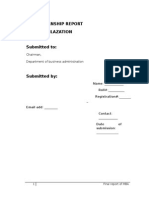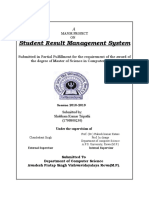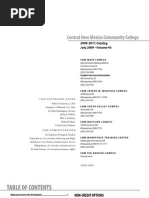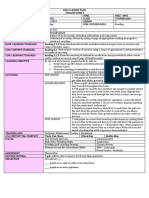NAAC Criteria Wise Assessment Indicators
NAAC Criteria Wise Assessment Indicators
Uploaded by
Krishna Kumar MishraCopyright:
Available Formats
NAAC Criteria Wise Assessment Indicators
NAAC Criteria Wise Assessment Indicators
Uploaded by
Krishna Kumar MishraOriginal Title
Copyright
Available Formats
Share this document
Did you find this document useful?
Is this content inappropriate?
Copyright:
Available Formats
NAAC Criteria Wise Assessment Indicators
NAAC Criteria Wise Assessment Indicators
Uploaded by
Krishna Kumar MishraCopyright:
Available Formats
Assessment Indicators
Criteria 1 Curricular Aspects (150)
Key Aspects
Assessment Indicators
1.1 Curriculum
Design and
Development
1.
Curriculum design is aligned with the institutional goals
and objectives.
2.
Curriculum design and development is done through a
well defined process.
3.
Curricula developed/ adopted have relevance to the
local/national/regional/global developmental needs.
4.
Employability & entrepreneurship, pursuit of higher
knowledge, overall development of students are major
considerations in the design and development of the
curriculum.
5.
Developing global competencies is evident in the
curriculum design.
6.
Consultation with academic experts, industry/
employment sector /alumni / other stakeholders within
and outside the institution is effectively done for
developing the curricula.
7.
Leadership is provided to affiliated colleges (if applicable)
for enriching the curriculum by encouraging skill
development, need based programmes, etc.
8.
The institution offers a number of program options leading
to different degrees, diplomas and certificates (UG/ PG/
PG Diploma/ Diploma Certificate).
9.
The curriculum offers a number of Choice Based Credit
System (CBCS) / elective options.
(50)
1.2. Academic
Flexibility
(50)
10. A number of new programs and program combinations
are developed/adopted to meet the needs of the students
and the society.
NAAC for Quality and Excellence in Higher Education
NAAC for Quality and Excellence in Higher Education
125
Manual for Self-study Universities
Key Aspects
Assessment Indicators
11. Options are available to students for additional/
supplementary / enrichment courses along with their
regular curricula. (Eg. UG degree + a Certificate PG degree
+ a diploma and so on).
12. The institution provides for inter-institutional credit
transfers.
13. The institution follows a semester system.
1.3. Curriculum
Enrichment
14. The institution revises the curriculum at regular
intervals and analyses the impact.
15. The curriculum provides adequate scope for introducing
programmes in emerging thrust areas/interdisciplinary
areas.
(30)
16. All learners have access to value-added programmes,
including communication skills / soft skills.
17. Structured feedback from students is an essential
component in the curricular design and development
process.
1.4. Feedback
System
(20)
18. The institution draws on the feedback from national and
international faculty.
19. Inputs from affiliated colleges are an essential part of the
feedback system (if applicable).
126
NAAC for Quality and Excellence in Higher Education
Manual for Self-study Universities
Criteria 2 Teaching-learning and Evaluation (200)
Key Aspects
Assessment Indicators
2.1. Student
Enrolment
and Profile
1.
The admission process of the institution is widely
publicized and is transparent.
2.
The institution has periodic reviews of its enrolment profile
and the outcomes are used for improvement of the process.
(10) 3. The institution has an inclusive admission policy catering
to diverse student groups.
2.2. Catering to
Student
Diversity
4.
The institution implements the statutory reservation
policies.
5.
The institution organises orientation programmes /
induction programmes for freshers.
6.
The institution assesses the learning levels of the students,
after admission and designs programmes for advanced
learners and slow learners.
7.
Analyses the academic growth of differently-abled students
and provides tutorials for needy students.
8.
The institution fosters an inclusive academic ambience.
9.
The institution meticulously plans and organizes its
teaching schedule.
(20)
2.3. Teachinglearning
Process
10. Student centered methods are an integral part of the
pedagogy adopted by the faculty.
11. Experiential learning, participative learning, problem
solving methodologies are used.
12. The institution has formal linkages with national agencies
like NMEICT to promote blended learning.
(50)
13. Latest technologies are used by the faculty for effective
teaching.
14. The learning environment is conducive for critical thinking,
creativity and scientific temper
NAAC for Quality and Excellence in Higher Education
127
Manual for Self-study Universities
Key Aspects
Assessment Indicators
15. The institution follows a system of mentor-mentee to meet
the academic and personal needs of students.
16. The institution gives due recognition to innovative and
creative contributions of its faculty and students.
17. Projects / field experiences are integrated into the learning
programmes.
18. Feedback on the evaluation of teachers is leveraged for
improvement of the quality of teaching-learning process.
19. The institution has adequate, well qualified faculty.
2.4. Teacher
Quality
20. Diversity in the recruitment of faculty is encouraged.
21. The institution facilitates the participation of its teachers
in teacher recharge programmes.
22. The institution ensures that teaching positions against
sanctioned posts are filled in reasonable time.
(50)
23. The institution adheres to UGC/ State Govt. norms for
faculty recruitment and promotion.
24. The institution organizes induction and in-service
academic development programmes for its faculty.
25. The institution attracts distinguished faculty for
appointment as emeritus / distinguished professors.
26. The faculty are encouraged to demonstrate creativity and
innovation in teaching.
27. The institution facilitates mobility of its faculty through
exchange programmes.
2.5. Evaluation
Process and
Reforms
28. The institution disseminates the evaluation processes to
all its stakeholders.
29. The institution adheres to the academic calendar for
conduct of examinations.
30. The institution ensures timely declaration of results. (for
Universities and Autonomous Colleges)
128
NAAC for Quality and Excellence in Higher Education
Manual for Self-study Universities
Key Aspects
Assessment Indicators
(40)
31. Reforms in the examination procedures and processes
have positively impacted the examination management
system. (for Universities and Autonomous Colleges)
32. Transparency and security of evaluation system is
ensured.
33. Technology is effectively used in the examination
management process.
34. The institution has an effective mechanism for redressal
of grievances pertaining to examinations.
35. The graduate attributes of the institution are clearly
defined /articulated
2.6. Student
Performance
and Learning
Outcomes
36. The institution ensures that its various programmes and
activities help acheive the stated graduate attributes.
37. The institution encourages all its departments to clearly
state the learning outcomes of its programmes.
(30)
38. The acheivement of intended learning outcomes is central
to the pedagogical and assessment processes of the
university.
39. The institution has mechanisms in place to analyze short
falls in achievement of learning outcomes and suggest
improvement measures.
40. New technologies are deployed by the institution to
enhance student learning.
NAAC for Quality and Excellence in Higher Education
129
Manual for Self-study Universities
Criteria 3 Research, Consultancy and Extension (250)
Key Aspects
Assessment Indicators
3.1. Promotion of
research
(20)
1.
The institution facilitates its faculty to undertake research
by providing research funds (seed money).
2.
Provision for research facilities in terms of laboratory
equipment, research journals and research incentives are
made available to the faculty.
3.
The institution encourages and promotes a research culture
(eg. teaching work load remission, opportunitites for
attending conferences etc.).
4.
The faculty are encouraged to undertake research by
colloborating with other research oraganizations/ industry.
5.
Faculty are given due recognition for guiding research.
6.
The institution has research committees for promoting and
directing research.
7.
The institution encourages the establishment of specific
research units/ centers by funding agency / university.
8.
The institution has a well defiend policy to promote
research in its affiliated / constituent colleges (for
universities).
9.
Workshops/ training programmes/ sensitization
programmes are conducted by the institution to promote
a research culture on campus.
10. The institution facilitates researchers of eminence to visit
the campus as adjunct professors (for universities).
11. The institution has a good percentage of faculty who have
utilized sabbatical leave for pursuit of higher research in
premier institutions within the country and abroad.
3.2. Resource
Mobilization
for Research
12. Financial provisions are made in the institutions budget
for supporting students research projects.
13. The institution takes special efforts to encourage its faculty
to file patents.
130
NAAC for Quality and Excellence in Higher Education
Manual for Self-study Universities
Key Aspects
Assessment Indicators
(20)
14. Projects sponsored by the industry / corporate houses
are availed by the institution.
15. The institution receives quantum of research grants from
external agencies for major and minor projects.
16.
3.3. Research
Facilities
The institution has recognised Research Centres. (National
and international, eg. UGC, ICSSR, ICHR, ICPR, DST,
DBT, UNESCO, UNICEF).
17. Efforts are made by the institution to improve its
infrastructure requirements to facilitate research.
18. The institution has a University Science Instrumentation
Centre (USIC) (for universities).
(30)
19.
Residential facilities (with computer and internet
facilities) for research scholars, post-doctoral fellows,
research fellows of various academies and visiting
scientists (national/international) are available.
20.
The institution has a specialized research centre/
workstation on-campus and off-campus to address the
special challenges of research programmes.
21. The institution has centres of national and international
recognition/repute.
22. Research facilities are enhanced through research projects.
3.4. Research
Publications
and Awards
23. Significant faculty involvement in research is evident.
24. The institution has an official Code of Ethics to check
malpractices and plagiarism in research.
25. Interdepartmental / interdisciplinary research projects
are undertaken.
26. The institution has instituted research awards.
27. Incentives are given to the faculty for receiving state,
national and international recognition for research
contributions.
NAAC for Quality and Excellence in Higher Education
131
Manual for Self-study Universities
Key Aspects
Assessment Indicators
(100)
28. Research awards and recognition are received by the
faculty and students from reputed professional bodies and
agencies.
29. Output in terms of M.Phil, Ph.D. students is significant.
30. The institution has received research recognition and
awards (including patents).
31. The institutions research has contributed to the industrys
requirements/ productivity.
32. A significant number of research articles are published in
reputed/ refereed journals.
33. The institution has published books and proceedings
based on research work of its faculty.
34. The institution is acclaimed for its research as evidenced
by metrics such as Citation Index, Impact Factor, h-index,
SNIP, SJR, etc.
35. The institution publicizes the expertise available for
consultancy services.
3.5. Consultancy
36. The institution renders consultancy services to industries.
(20)
37. The institution renders consultancy services to
Government / Non- Government organizations/
community/ public.
38. Resources (financial and material) are generated through
consultancy services of the institution.
39. Mutual benefits accrued due to consultancy.
40. The institution has an official policy for structured
Consultancy.
3.6. Extension
Activities and
Institutional
Social
Responsibility
41. The conduct of extension activities is promoted by the
institution.
42. Need-based extension programmes are organised.
43. Students and faculty participate in extension programmes.
44. NSS/NCC activities are organised.
132
NAAC for Quality and Excellence in Higher Education
Manual for Self-study Universities
Key Aspects
Assessment Indicators
45. Awards and recognitions have been received for extension
activities.
(40)
46. The impact of extension activities on the community goes
through a cycle of evaluation, review and upgrading the
extension programmes.
47. Partnerships with industry, community and NGOs for
extension activities are established.
48. The institution has a mechanism to track the students
involvement in various social movements / activities
which promote citizenship roles.
49. The institution is cognisant of its Institutional Social
Responsibilities (ISR).
50. All constituents of the institution are made aware of its
ISR.
51. The institution has linkages for various activities such as
faculty exchange, student placement, etc.
3.7. Collaborations
52. The linkages established by the institution have enhanced
its academic profile.
53. Specific examples of linkages to promote curriculum
development, internship, on-the-job training, faculty
exchange and development, research, etc.
(20)
54. The institution has MoUs with institutions of national/
international importance/other universities/ industries/
corporate houses etc.
55. Institute-industry interactions have resulted in the
establishment / creation of highly specialized laboratories
/ facilities.
56. The impact of the institutional collaborations are formally
reviewed.
NAAC for Quality and Excellence in Higher Education
133
Manual for Self-study Universities
Criteria 4 Infrastructure and Learning Resources (100)
Key Aspects
Assessment Indicators
4.1. Physical
Facilities
(30)
4.2. Library as a
Learning
Resource
1.
The institution has adequate facilities for teachinglearning.
2.
The institution provides necessary facilities for
laboratories. (Furniture, fixtures, equipment and good
laboratory practices)
3.
The institution has adequate facilities for general computer
education of students.
4.
Infrastructural facilities are augmented from time to time.
5.
Infrastructure facilites are being utilised optimally.
6.
Additional facilities for sports and extra- curricular
activities (gymnasium, swimming pool, auditorium etc.)
are provided.
7.
Health services for students, teaching and non-teaching
are provided by the institution.
8.
The institution facilitates active academic participation of
physically disabled students by providing the necessary
facilities.
9.
The library has adequte physical facilities such as reading
room, reprography, internet.
10. Number of book titles per student (in the central library)
excluding book bank is greater than 80.
11. The library is stocked with adequate number of journals
(national + international) and other library resources (i.e.
CDs/ cassettes, etc.).
12.
(20)
Library resources are augmented every year with newer
editions and titles.
13. The library operations (issue of books, getting the
necessary references, etc) are effective and user-friendly.
14. The Library Advisory Committee is responsible for the
effective functioning of the library.
134
NAAC for Quality and Excellence in Higher Education
Manual for Self-study Universities
Key Aspects
Assessment Indicators
15. The library collects feedback from users and incorporates
the suggestions for its enhanced functioning.
16. The library is computerized and networked with other
libraries.
4.3. IT
Infrastructure
17. The institution frequently upgrades its IT facility and has
latest computing facilities hardware and software.
18. The faculties are provided with the requisite facilities for
preparation of computer aided teaching learning material.
(30)
19. The institution is connected with the National Knowledge
Network and other such facilities.
20. Budget provision is made for purchase, upgrading and
maintenance of computers.
4.4. Maintenance of
Campus
Facilities
21. The institution has a budget for maintenance of the
facilities available on the campus physical facilities and
academic support facilities.
22. There are established procedures and systems for
maintaining and utilising physical and academic support
(20)
facilities library, sports complexes, computer, classrooms
etc.
23. The funds allocated for maintenance of infrastructure are
utilised in total for the planned activities.
NAAC for Quality and Excellence in Higher Education
135
Manual for Self-study Universities
Criterion 5 - Student Support and Progression (100)
Key Aspects
5.1 Student
Mentoring and
Support
(40)
Assessment Indicators
1.
The institution has an independent system for student
support and mentoring (for universities).
2.
Adequate student welfare measures (scholarships,
freeships, insurance, etc.) are provided by the institution.
3.
Personal enhancement and development schemes
coaching classes for competitive examinations, career
counseling, soft skill development, etc. are available to
the students.
4.
Information about the institution is publicly accessible.
5.
The institution has an international students cell to cater
to the requirements of foreign students (for universities).
6.
Student participation in co-curricular and extra-curricular
activities is encouraged.
7.
The institution has a placement cell which helps to identify
job opportunities and develop entrepreneurship skills.
8.
On-campus interviews are an essential mechanism to
ensure student placement (for universities).
9.
The Alumni Association contributes significantly to the
development plans of the institution.
10. The institution has a mechanism for timely redressal of
student greivanaces.
11. The institution has an anti-ragging committee which
monitors student interactions effectively.
12. Specific student support is provided for SC, ST, OBC, PWD
and economically weaker sections of society.
13. The institution has a mechanism for prevention of sexual
(gender) harassment.
136
NAAC for Quality and Excellence in Higher Education
Manual for Self-study Universities
Key Aspects
Assessment Indicators
5.2 Student
Progression
14. The progression of students in various programmes of
the institution is regularly monitored.
15. The institution makes special efforts to reduce its dropout
rate and increase its pass percentage.
(40)
16. The institution facilitates and monitors timely submission
of Ph.D./D.Litt./D.Sc. theses. (for universities)
17. The institution has a successful track record of students
appearing and qualifying in competitive examinations.
18. The institution has a range of games, extra-curricular
activities which contribute to overall development of
students.
5.3 Student
Participation
and Activities
19. Feedback from students is used for planning and
developing support services.
20. Active student participation through Student Councils is
encouraged.
(20)
21. Students are represented on academic and administrative
bodies of the institution.
22. Institution facilitates for students to publish materials like
catalogues, wall magazines, institution magazines, etc. (for
Autonomous Colleges and Affiliated/Constituent Colleges)
23. Student participation in state, national and international
level sports events is encouraged.
NAAC for Quality and Excellence in Higher Education
137
Manual for Self-study Universities
Criteria 6 Governance, Leadership and Management (100)
Key Aspects
Assessment Indicators
6.1. Institutional
Vision and
Leadership
1.
The vision, mission and goals of the institution are in tune
with the objectives of higher education.
2.
The governance of the institution is reflective of an effective
leadership.
3.
The institution practices decentralization and participative
management.
4.
The institution provides academic leadership to its
affiliated colleges. (for Universities)
5.
The institution formulates its strategic planning and
interacts with stakeholders.
6.
The institution monitors and evaluates its policies and
plans.
7.
The institution grooms leadership at various levels.
8.
All decisions of the institution are governed by
management of facts, information and objectives.
9.
Perspective plan document is an important component of
the institutions strategy development and deployment
process.
(10)
6.2. Strategy
Development
and
Deployment
10. The institution has a well defined organisational structure
with effective processes developed for all its major
activities.
11. The institution has an effective feedback system involving
all stakeholders.
(10)
12. The institution has a well defined Quality Policy and
deployed with a systems perspective.
13. The institution has an action plan and schedules for its
future development.
13. The institution has an effective Grievance Redressal Cell.
138
NAAC for Quality and Excellence in Higher Education
Manual for Self-study Universities
Key Aspects
Assessment Indicators
15. Management and monitoring of the affiliated colleges is
effectively handled by the institution.
16. Student Satisfaction Survey is an integral input factor for
all policies of the institution.
6.3. Faculty
Empowerment
Strategies
17. The institution takes sustained interest in recruitment and
promotion aspects of its employees.
18. The institution adheres to GOI/ State Govt. policies on
recruitment (access, equity, gender sensitivity and
physically disabled).
12. The institution has an effective welfare mechanism for
teaching and non-teaching staff.
20. The institution ensures transparent use of Performance
Appraisal Reports.
(30)
21. The institution conducts programmes to enhance the
competency of its faculty and non-teaching staff.
22. Performance budgeting is a core planning activity used
by the institution for informed decision making.
23. The institution incorporates gender auditing to enhance
inclusiveness.
24. Effective welfare mechanisms of the institutions are
available to its teaching and non-teaching staff.
25. The institution conducts programme for professional
development of its staff.
26. Impact of Academic Staff College programmes forms an
important feedback for improvement of programmes. (for
Universities)
6.4. Financial
Management
and Resource
Mobilization
27. The institution has adequate budgetary provisions for
academic and administrative activities.
28. Optimal utilization of budget is strictly adhered to by the
institution.
NAAC for Quality and Excellence in Higher Education
139
Manual for Self-study Universities
Key Aspects
Assessment Indicators
(20)
29. Monitoring financial management practices through
internal audit is evidenced in the institutions financial
health.
30. The institution maintains a Reserve and Corpus fund.
31. The institution has conducted internal and external audits
are regularly conducted.
32. The institution and leadeship takes initiatives for
mobilization of resources.
33. Academic audit of departments and its impact is an
important quality initiative of the institution.
6.5. Internal
Quality
Assurance
System
34. The institution has an effective quality management and
enhancement systems.
(30)
35. The institution reviews its teaching learning process,
structure, methodologies of operations and learning
outcomes at periodic intervals.
36. Internal Quality Assurance Cell (IQAC) has contributed
significantly to institutionalizing quality assurance
strategies and processes.
37. External members contribute significantly in the
functioning of the IQAC.
38. Autonomy to academic departments is encouraged.
140
NAAC for Quality and Excellence in Higher Education
Manual for Self-study Universities
Criteria 7 Innovations and Best Practices (100)
Key Aspects
Assessment Indicators
7.1. Environment
Consciousness
(30)
7.2. Innovations
1.
Green audit.
2.
Promotion of eco-friendly campus.
3.
E-waste management.
4.
Open ended peer team members to identify the
characteristics of the innovation.
5.
Open ended peer team members to decide on the
efficacy of the practice.
(30)
7.3. Best Practices
(40)
NAAC for Quality and Excellence in Higher Education
141
Manual for Self-study Universities
142
NAAC for Quality and Excellence in Higher Education
You might also like
- Msi BrochureDocument25 pagesMsi Brochurevisionrajput2005No ratings yet
- Helping English Learner SuccessDocument174 pagesHelping English Learner Successndk4d1100% (18)
- Syllabus Montgomery Beginner Adult EslDocument3 pagesSyllabus Montgomery Beginner Adult Eslapi-355425447No ratings yet
- William Li's ResumeDocument1 pageWilliam Li's ResumeWilliam LiNo ratings yet
- Panay Elementary School: District of MabiniDocument4 pagesPanay Elementary School: District of MabiniJenepher Ilagan Ilagan100% (8)
- Meaning of Words Used in NAAC CriteriaDocument10 pagesMeaning of Words Used in NAAC CriteriawallraNo ratings yet
- Marry's College NAACDocument386 pagesMarry's College NAACShanthiniSampath0% (1)
- Naac Self Study Report PDFDocument469 pagesNaac Self Study Report PDFSanjithRNairNo ratings yet
- User Manual 906354Document15 pagesUser Manual 906354Corona Virus100% (1)
- Manasa GITAM PROJECTDocument96 pagesManasa GITAM PROJECTsoundarya susarlaNo ratings yet
- Full Doc Brain TumorDocument102 pagesFull Doc Brain TumorbavyoNo ratings yet
- Final RepotDocument48 pagesFinal Repotarvimahe01No ratings yet
- Team14 Mini Report FINALDocument61 pagesTeam14 Mini Report FINALR.Sandhya RaniNo ratings yet
- SUMITA-1 ResumeDocument9 pagesSUMITA-1 ResumeengineeringwatchNo ratings yet
- Kakatiya Institute of Technology & ScienceDocument1 pageKakatiya Institute of Technology & ScienceMulukallavinay ReddyNo ratings yet
- Ibrahim's Viva Voce LetterDocument2 pagesIbrahim's Viva Voce LetterRAMA KOTESHNo ratings yet
- Iit - Bombay Annual ReportDocument96 pagesIit - Bombay Annual Reportfirefist_ashNo ratings yet
- Amity CV FormatDocument2 pagesAmity CV FormatLUCAS-1No ratings yet
- MBA - NSUT - 26.9.2020 FinalDocument27 pagesMBA - NSUT - 26.9.2020 FinalshubNo ratings yet
- Work Integrated Learning ProgrammesDocument7 pagesWork Integrated Learning Programmespdparthasarathy03No ratings yet
- Embedded Web ServerDocument87 pagesEmbedded Web Serverसन्तोस दाहालNo ratings yet
- NAAC Report SSR CollegeDocument291 pagesNAAC Report SSR CollegeKaruppannanmariappancollege Kmc100% (2)
- Visvesvaraya Technological University Belagavi, Karnataka-590 018Document31 pagesVisvesvaraya Technological University Belagavi, Karnataka-590 018Manoj ,No ratings yet
- MBA Study On Organisational Culture and Its Impact On Employees Behaviour 237652089Document63 pagesMBA Study On Organisational Culture and Its Impact On Employees Behaviour 237652089Manoj MassNo ratings yet
- HostelDocument59 pagesHostelZtony JosephNo ratings yet
- A Report On "Material Storage Layout and Inventory Management"Document37 pagesA Report On "Material Storage Layout and Inventory Management"Pankaj AgriNo ratings yet
- An Internship Presentation On Search Engine Optimization at Saayami TechnologyDocument28 pagesAn Internship Presentation On Search Engine Optimization at Saayami TechnologyDipesh TripathiNo ratings yet
- Intern Report FormatDocument4 pagesIntern Report FormatPunit Pg0% (1)
- Statement of Purpose For NANODocument1 pageStatement of Purpose For NANOAshwani AnandNo ratings yet
- Summer Training Format MDU (MBA)Document3 pagesSummer Training Format MDU (MBA)Ujjwal0% (1)
- Dissertation E-LearningDocument60 pagesDissertation E-Learningmaryam sherazNo ratings yet
- Muhammad Usman: Civil Engineer, UET LahoreDocument1 pageMuhammad Usman: Civil Engineer, UET LahoreNouman MughalNo ratings yet
- Bonafide Student HostelDocument22 pagesBonafide Student HostelSuresh Gandhi100% (1)
- Resume 1Document2 pagesResume 1Sandeep PusaNo ratings yet
- Naac Presentation Gse 8-3-24Document44 pagesNaac Presentation Gse 8-3-24arjunnichalNo ratings yet
- Master of EducationDocument107 pagesMaster of EducationAbhishekNo ratings yet
- Satish-B-Tech in Mechanical Engineer FresherDocument4 pagesSatish-B-Tech in Mechanical Engineer Freshersatish100% (1)
- Course: BBA, 1 Year: Submitted By: Kritika SinghDocument5 pagesCourse: BBA, 1 Year: Submitted By: Kritika SinghHaleen kaurNo ratings yet
- Reseach Topic Smartschool Education PVT LTD Final 1Document40 pagesReseach Topic Smartschool Education PVT LTD Final 1Yash Pratap SinghNo ratings yet
- Mba Internship Report RevisedDocument62 pagesMba Internship Report RevisedMuji_MSNo ratings yet
- Man Is Ha ReportDocument66 pagesMan Is Ha ReportKapil Reddy SudharmaNo ratings yet
- Engineering Chemistry Lab ManualDocument31 pagesEngineering Chemistry Lab ManualRiyaz MohammedNo ratings yet
- Ali Research 3 (LSCM) - 1Document47 pagesAli Research 3 (LSCM) - 1bezawitwubshetNo ratings yet
- Project Report Batch 4 .1Document18 pagesProject Report Batch 4 .1mantosh kumarNo ratings yet
- IQACfinal 1Document25 pagesIQACfinal 1MVNo ratings yet
- A - Project - Report - On - Bca MR OnkarDocument94 pagesA - Project - Report - On - Bca MR OnkarjayNo ratings yet
- MBA Akshay Arora: SAP ID:80511020627 - : Akshay - Arora27@nmims - Edu.in - Age: 23Document2 pagesMBA Akshay Arora: SAP ID:80511020627 - : Akshay - Arora27@nmims - Edu.in - Age: 23gautam keswaniNo ratings yet
- Project Report On Education in GujratDocument53 pagesProject Report On Education in Gujratruchira suranaNo ratings yet
- BISWA CV Now Working in Tata Steel. With PhotoDocument4 pagesBISWA CV Now Working in Tata Steel. With PhotoTwinkle SahooNo ratings yet
- Bi Tools A Synergistic Opportunity For Organizational Growth and Quality Decision Making in It Organizations (2) - 1Document79 pagesBi Tools A Synergistic Opportunity For Organizational Growth and Quality Decision Making in It Organizations (2) - 1Maankar AbhijeetNo ratings yet
- Project Guide Allotment Student ListDocument1 pageProject Guide Allotment Student Listritesh8315No ratings yet
- Summer Training LetterDocument1 pageSummer Training LetterMohd SalmanNo ratings yet
- Motivaton LetterDocument1 pageMotivaton LetterQusai KHNo ratings yet
- Submitted To: Faculty Guide: Anandi Sarkar Pyne Industry Guide: Meghhaa WoraahDocument16 pagesSubmitted To: Faculty Guide: Anandi Sarkar Pyne Industry Guide: Meghhaa WoraahK SrinivasNo ratings yet
- Internship ReportDocument19 pagesInternship ReportPratik PatidarNo ratings yet
- Internship ReportDocument35 pagesInternship ReportArshiya BanuNo ratings yet
- Srujana DocumenatationDocument69 pagesSrujana DocumenatationCharitha IddumNo ratings yet
- Student Result Management System: Major Project ONDocument57 pagesStudent Result Management System: Major Project ONs sunil k kumar100% (1)
- An Integrated GIS, MIF, and TOPSIS Approach For Appraising Electric Vehicle Charging Station Suitability Zones in Mumbai, India.Document54 pagesAn Integrated GIS, MIF, and TOPSIS Approach For Appraising Electric Vehicle Charging Station Suitability Zones in Mumbai, India.Fidelis O. AjibadeNo ratings yet
- Detection of Phishing Websites Using Machine Learning IJERTV10IS050235Document5 pagesDetection of Phishing Websites Using Machine Learning IJERTV10IS050235vardhan reddyNo ratings yet
- 5G Project AMAN (1) NewDocument46 pages5G Project AMAN (1) NewMonty MishraNo ratings yet
- Arunai Naac Related ChecklistDocument174 pagesArunai Naac Related ChecklistAdvisor A.C.TNo ratings yet
- NAACCDocument144 pagesNAACCsmss_proe5945No ratings yet
- Assignment: Approximately of 400 Words. Each Question Is Followed by Evaluation SchemeDocument1 pageAssignment: Approximately of 400 Words. Each Question Is Followed by Evaluation SchemeKrishna Kumar MishraNo ratings yet
- A Study On The Awareness Level of Lic Policy Holders in Salem DistrictDocument10 pagesA Study On The Awareness Level of Lic Policy Holders in Salem DistrictKrishna Kumar MishraNo ratings yet
- General ChemistryDocument239 pagesGeneral Chemistrylaode100% (1)
- Iop Report PhysicsDocument16 pagesIop Report PhysicsKrishna Kumar MishraNo ratings yet
- Photovoltaics ReportDocument42 pagesPhotovoltaics ReportKrishna Kumar MishraNo ratings yet
- RE Technologies Cost Analysis-SOLAR PVDocument52 pagesRE Technologies Cost Analysis-SOLAR PVKrishna Kumar MishraNo ratings yet
- MB0048 - Operation Research Set-1Document18 pagesMB0048 - Operation Research Set-1Krishna Kumar MishraNo ratings yet
- 221 Meeting Minutes FinalDocument157 pages221 Meeting Minutes FinalKrishna Kumar MishraNo ratings yet
- AdvtJune2013 01 AF01Document6 pagesAdvtJune2013 01 AF01Krishna Kumar MishraNo ratings yet
- DiffusionDocument2 pagesDiffusionKrishna Kumar MishraNo ratings yet
- Ips FormDocument2 pagesIps FormKrishna Kumar MishraNo ratings yet
- Acft Run LengthDocument45 pagesAcft Run LengthKrishna Kumar Mishra100% (1)
- Bassai SamplerDocument4 pagesBassai Samplerhazard123No ratings yet
- Observation Activity 8th GradeDocument3 pagesObservation Activity 8th GradehevelascoNo ratings yet
- Giao An Tieng Anh 11 Hay Nhin La Muon TaiDocument315 pagesGiao An Tieng Anh 11 Hay Nhin La Muon TaiLe Hoang LinhNo ratings yet
- Post Observation 1Document3 pagesPost Observation 1api-252534442No ratings yet
- AnnouncementDocument10 pagesAnnouncementYudi RahmandaNo ratings yet
- Arekag - CKACS Newspaper - 16 - 01Document4 pagesArekag - CKACS Newspaper - 16 - 01Charlie Keyan Armenian Community SchoolNo ratings yet
- Cronasia Foundation College Inc.: TLE - IAEI7/8UT-0a-1Document9 pagesCronasia Foundation College Inc.: TLE - IAEI7/8UT-0a-1noyNo ratings yet
- English Thinking Maps: Activity: Vocabulary Circle Map Level: ObjectivesDocument3 pagesEnglish Thinking Maps: Activity: Vocabulary Circle Map Level: ObjectivesTcer ItaNo ratings yet
- Principal Memo & Action PlanDocument3 pagesPrincipal Memo & Action PlancarmenmcqueenNo ratings yet
- Open Forum 2 Web Site Worksheet: 1. Preparing To ListenDocument1 pageOpen Forum 2 Web Site Worksheet: 1. Preparing To ListenEnglish NCKUNo ratings yet
- IELTS EssayDocument13 pagesIELTS EssayVinay PillaiNo ratings yet
- KKKKJKKKDocument2 pagesKKKKJKKKArvin JayloNo ratings yet
- CBAR RRLDocument14 pagesCBAR RRLRichniel OlamitNo ratings yet
- Readers Theater RubricDocument1 pageReaders Theater RubricMs. Xeni100% (2)
- Simple Linear Regression ExampleDocument3 pagesSimple Linear Regression Examplekiran_wakchaure100% (1)
- Grade 8 Lesson Plan Situational ApproachDocument3 pagesGrade 8 Lesson Plan Situational ApproachMike Jerome Muga100% (1)
- Educ 216 - The Teaching Profession: Paul Kenneth A. PenuelaDocument15 pagesEduc 216 - The Teaching Profession: Paul Kenneth A. PenuelaPaul Kenneth Arca PenuelaNo ratings yet
- Citing Secondary or Indirect Sources REVISED 2014Document2 pagesCiting Secondary or Indirect Sources REVISED 2014CUNG DINHNo ratings yet
- Kurukshetra University, Kurukshetra: Ordinance and Application Form (2015-16) For Doctorate in PhilosophyDocument19 pagesKurukshetra University, Kurukshetra: Ordinance and Application Form (2015-16) For Doctorate in PhilosophyMahi SinghNo ratings yet
- Review For YouDocument1 pageReview For YourawadNo ratings yet
- UGC Paper1Document5 pagesUGC Paper1Kumarushes IlrrinaNo ratings yet
- JustificationDocument2 pagesJustificationHazwan AsyrafNo ratings yet
- CNM 09-11 Catalog LowresDocument328 pagesCNM 09-11 Catalog LowresJohn R. NitschkeNo ratings yet
- UNT Lesson Plan TemplateDocument3 pagesUNT Lesson Plan Templateapi-273347960No ratings yet
- English 1a 2017Document15 pagesEnglish 1a 2017api-333990095No ratings yet
- Form 3 Lesson 2Document1 pageForm 3 Lesson 2Ami Amnaida HamidNo ratings yet
- Piano EssayDocument2 pagesPiano EssayKalil MenezesNo ratings yet





































































































